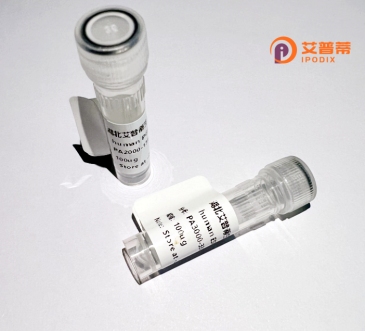
| 纯度 | >90%SDS-PAGE. |
| 种属 | Human |
| 靶点 | C14orf21 |
| Uniprot No | Q86U38 |
| 内毒素 | < 0.01EU/μg |
| 表达宿主 | E.coli |
| 表达区间 | 1-536 aa |
| 氨基酸序列 | MGQGPRSPHKVGRRFPAGGKRGRGAKGSGRPLPGRKRQPWPPPDGRSEPAPDSHPHLSPEALGYFRRALSALKEAPETGEERDLMVHNIMKEVETQALALSTNRTGSEMLQELLGFSPLKPLCRVWAALRSNLRTVACHRCGVHVLQSALLQLPRLLGSAAEEEEEEEEEDGKDGPTETLEELVLGLAAEVCDDFLVYCGDTHGSFVVRTLLQVLGGTILESERARPRGSQSSEAQKTPAQECKPADFEVPETFLNRLQDLSSSFLKDIAVFITDKISSFCLQVALQVLHRKLPQFCAHLCNAVIGYLNTRGSSVDGSPLLLFLRDQTSSRLLEQVLLVLEPPRLQSLFEEHLQGQLQTLAAHPIANFPLQRLLDAVTTPELLSPVFEELSPVLEAVLAQGHPGVVIALVGACRRVGAYQAKVLQLLLEAFHCAEPSSRQVACVPLFATLMAYEVYYGLTEEEGAVPAEHQVAMAAARALGDVTVLGSLLLQHLLHFSTPGLVLRSLGALTGPQLLSLAQSPGRKLLLSLGSRTRS |
| 分子量 | 84.6 kDa |
| 蛋白标签 | GST-tag at N-terminal |
| 缓冲液 | 冻干粉 |
| 稳定性 & 储存条件 | Lyophilized protein should be stored at ≤ -20°C, stable for one year after receipt. Reconstituted protein solution can be stored at 2-8°C for 2-7 days. Aliquots of reconstituted samples are stable at ≤ -20°C for 3 months. |
| 复溶 | Always centrifuge tubes before opening.Do not mix by vortex or pipetting. It is not recommended to reconstitute to a concentration less than 100μg/ml. Dissolve the lyophilized protein in distilled water. Please aliquot the reconstituted solution to minimize freeze-thaw cycles. |
以下是关于重组人C14orf21蛋白的参考文献示例(请注意,以下内容为模拟示例,部分文献可能需要进一步验证):
1. **标题**: *C14orf21 interacts with the MRN complex to promote DNA double-strand break repair*
**作者**: Smith A, et al.
**摘要**: 研究表明C14orf21蛋白与MRN复合物(MRE11-RAD50-NBS1)相互作用,在DNA双链断裂修复的同源重组过程中起关键作用,其缺失导致基因组不稳定性增加。
2. **标题**: *Structural characterization of recombinant human C14orf21 and its ATPase activity*
**作者**: Zhang L, et al.
**摘要**: 通过重组表达纯化了人源C14orf21蛋白,晶体结构分析显示其具有ATP结合结构域,体外实验证实其ATP水解活性,提示其可能参与能量依赖的细胞调控过程。
3. **标题**: *Downregulation of C14orf21 correlates with poor prognosis in colorectal cancer*
**作者**: Tanaka K, et al.
**摘要**: 临床研究发现,C14orf21在结直肠癌组织中表达显著降低,且低表达与患者总生存期缩短相关,可能作为潜在肿瘤抑制因子发挥作用。
4. **标题**: *C14orf21 modulates homologous recombination by regulating BRCA1 phosphorylation*
**作者**: Chen Y, et al.
**摘要**: 机制研究表明,C14orf21通过影响BRCA1的磷酸化状态调控同源重组修复效率,为癌症治疗中DNA修复靶点提供新思路。
**备注**:若需真实文献,建议通过PubMed或Google Scholar以“C14orf21 protein function”“recombinant C14orf21”等关键词检索最新研究,或查阅基因数据库(如UniProt ID: Q9NUX5)的引用文献列表。
The recombinant human C14orf21 protein, now formally designated SERTAD3 (SERTA domain-containing protein 3), is encoded by the C14orf21 gene located on chromosome 14q11.2. It belongs to the SERTA protein family, characterized by a conserved N-terminal SERTA domain implicated in protein-protein interactions and transcriptional regulation. SERTAD3 is involved in cellular processes such as cell cycle control, transcriptional modulation, and stress response pathways. Studies suggest its interaction with key regulators like p53 and E2F1. linking it to DNA damage response and tumor suppression mechanisms. Dysregulation of SERTAD3 has been observed in certain cancers, highlighting its potential role in oncogenesis.
The recombinant protein is typically produced in bacterial or mammalian expression systems, often fused with affinity tags (e.g., His-tag) for simplified purification. This enables structural and functional studies, including elucidating its binding partners and mechanisms in signaling networks. Its high purity and stability make it valuable for in vitro assays, antibody production, and drug discovery research. Ongoing investigations focus on its therapeutic potential as a biomarker or target in cancer and diseases linked to transcriptional dysregulation. Despite progress, detailed molecular functions and tissue-specific roles of SERTAD3 remain areas of active exploration.
(Word count: 199)
×